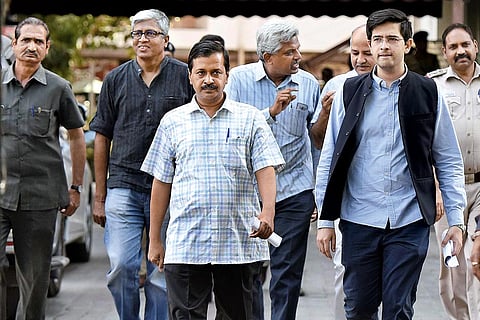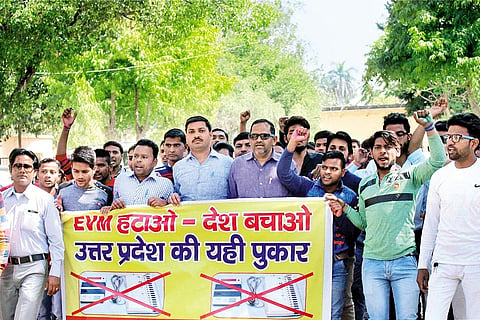Suddenly, the battle over electronic voting machines (EVMs) is at a feverish pitch. Whether they reliably record the voter’s choice has become a point of renewed debate now after one EVM in Madhya Pradesh allegedly registered only BJP votes. The machine was identified during a mock trial at a polling station, where it “malfunctioned” in full view of the media and representatives of political parties. The EVM was to be deployed at an April 9 byelection to Ater assembly seat in Bhind district.
Symptom Of Transitional Hiccup, Is It?
A pre-bypoll EVM demo went wrong, embarrassing the ECI. But it needn’t be proof of faulty machines.
Such public demonstrations of EVMs are typically conducted by the Election Commission of India (ECI) and its state chapter to reassure citizens that EVMs are easy to use and that every vote is safe. The entire affair went horribly wrong on March 31. Predictably, that sent a signal of triumph to political parties that have been clamouring for a return to manual voting. The Congress, Aam Aadmi Party and the Bahujan Samaj Party enjoyed a sense of vindication, which is matched by the denunciatory tone—equal and opposite in vigour—of their critics as well as opponents.
The ECI reiterates the machines as safe, citing an India-specific reason: the EVMs are standalone, not connected to each other by wire or airwave, unlike the case with other countries. The poll body has also countered the more serious charge of EVMs being rigged. The machines cannot be pre-set to make a party win, it reassures, pointing to the wholesale adoption of a special new device. Called ‘voter verifiable paper audit trail’ or VVPAT, it prints an accompanying slip that confirms the voter’s selection. This, the ECI believes, will put an end to the growing scepticism.

The mock-vote in Madhya Pradesh, thus, has a nuance: it was meant to demonstrate the working of VVPATs—not EVMs. Now, this point has a two-fold significance. First, those who are critical of EVMs ever since the Bhind episode are getting it completely wrong. The errors, if any, were with the printer there and not with the voting machine. “The VVPAT is just a printer. It doesn’t record a vote,” an ECI official explains. “See, in Bhind, we just wanted to show how the VVPAT works, not how voting machines work.”
Whatever the truth, the matter holds great significance for voters and political parties. Indian democracy rests on the voting process—what seems like a periodic and seemingly mechanical act of casting votes is often the only actively democratic exercise by an Indian citizen. Hence, the Election Commission has taken the matter seriously, deploying a high-level team to monitor polls in the state. Bhanwar Lal, Andhra Pradesh’s chief electoral officer, is in Bhind to probe what went wrong at the trial.
The ongoing battle over EVMs has had its sour moments. A piqued EC, after repeatedly saying that EVMs are “tamper-proof”, chastised the AAP. In a recent note, it called Arvind Kejriwal’s party, though not in so many words, a sore loser—alluding to the AAP’s performance below its own expectations in the recent Punjab Assembly elections. Today, the EC’s trial in Bhind has itself become a subject of mockery.
Wealthy nations of the world still go by paper ballots. This, seen from the AAP’s eyes, is a hint at the unreliability of voting machines. Many other critics feel that rich countries, especially in Europe, even today prefer paper ballots to voting machines as they consider the manual exercise more trustworthy. They argue that insufficient awareness about the EVM pitfalls has led to the machine capturing the electoral territory in large developing societies.
The EVM error at Bhind made the state’s electoral officials unable to control the narrative. For, the awkward scene unfolded before a large crowd of political activists, onlookers and media persons. The other implication, obviously, is that the VVPAT itself might lose some credibility. The printer will be perceived, if not as error-prone, as certainly not foolproof (though the ECI is still locating what exactly went wrong).

A BSP-allied outfit holds an anti-EVM demonstration in Meerut
A VVPAT allows the voter to see whom he or she has voted for. The slip it throws up records the name, serial number and symbol of the candidate selected. The slip can’t be taken home by the voter, but is visible through a screen—for seven seconds—once the vote is cast on the EVM. After this, the printout automatically falls into a sealed box, never coming into the voter’s hands. Reason: in the event of a known EVM fault or dispute, the printouts can be counted to ascertain the electoral result. If the VVPAT can go wrong, the seeds of doubt get sown. Thus, this is one perception the ECI seeks to fight, repeatedly, clarifying that the Bhind was not a pattern but, possibly, an error under investigation.
The intricacies apart, some feel all isn’t well with the system. “One should have the right to choose how to vote—by paper ballot or EVM,” says Dr Anand Rai, the Vyapam scam whistleblower. “It’s not about winning or losing. Many popular, previously-successful leaders are losing by massive margins. This trend is baffling. I feel it is bad to not address it.” If government officials get postal ballots, so should ordinary voters, he adds.
India is switching to VVPATs for the 2019 parliamentary elections, but getting over this transition will take time. “We have placed proposals before for requisite funds to replace older machines,” says Sudeep Jain, the director-general of the ECI, in Delhi. The original funding proposal, made in January 2014, was for Rs 3,174 crore. The subsequent NDA government has announced it will release Rs 2,000 crore. At 2013 prices, a VVPAT machine costs about Rs 20,000. Possibly, prices will change once the Goods and Services Tax is rolled out in July.
The ECI, as a rule, also phases out a voting machine after 15 years of service. Thus, around 9.30 lakh voting machines will expire between 2016 and 2019. This year, it is supposed to replace a little over 19 lakh machines. Around 33 lakh will be due for replacement next year and another 12 lakh by 2019-20 so as to meet its target (of complete replacement).
The other option is to replace 14 lakh machines with a new-generation EVM. Named ‘M3 type’, this variety ceases to function if there is an attempt to tamper with it. This will require over Rs 5,500 crore. The choice, therefore, is between moving wholesale to VVPAT or to switch to the new kind of machine. That said, the government has not provided for such massive funding.
The BJP recently won several ‘historic’ mandates, and the one in Uttar Pradesh triggered the ongoing outcry. Will the BJP bring VVPATs on all EVMs sooner, despite the hefty price tag? “The ECI has made many technical improvements and introduced administrative safeguards as a result of individual efforts by some of us six years ago. VVPAT is one such contribution,” says party spokesperson G.V.L. Narasimha Rao, who wrote a 2011 book that was critical of EVMs and their working. “Many senior BJP leaders at that time did not feel the need for any safeguards,” he shrugs.
As for last month’s Bhind episode, the EC has clarified that the machine used in that trial was only an appendage to the demonstration on how VVPATs work. Even so, that EVM was not, after all, brought from Kanpur in Uttar Pradesh. “That’s just a rumour,” says the official. “The EC does not move machines from one state to another. Our VVPATs, yes, they do travel.”
This particular VVPAT was not “wiped clean” as it should have been, the officer says. The rules do clearly specify that all data in them should be erased before they are used even in a demonstration. Not having done so has caused a lot of trouble. Nineteen state officials, including a very popular district magistrate, have been transferred out. If anything, this indicates the growing concerns about EVMs and the need to correct the public perception on the machines.
The Commission has faced many a strident allegation from Mayawati’s BSP, AAP and the Congress. Many surfaced after candidates signed off on election results, which were then declared by the ECI. Such a declaration, once made, ends the Commission’s jurisdiction on the matter. Disputes now have to be tackled by the courts, via formal election petitions. No doubt, the EC feels under siege, as the attention of most EVM critics stays focused on it.
Critics of the EVM say it can be “pre-set” to lead an election to an already-determined verdict. “It isn’t that difficult to do such programming, and ordinary voters will never even suspect it,” says Dr Rai. “The kind of verdicts we are seeing—MLAs winning by margins of 90,000 votes in assemblies with less than 2 lakh voters, for instance. There’s something unnatural, unbelievable in them.”
Even local-body elections, many say, has had surprising results: a Mumbai candidate has said he got no vote—not even his own. In Panchvati, also in Maharashtra, votes allegedly totalled more than the electorate number, leading to vandalism in the town’s streets. In Yerawada, 15 candidates including Manisha Mohite (NCP), complained about being declared winners, then losers—the confusion was attributed to a single EVM not having been counted. The ECI does not conduct panchayat or civic polls. These machines are beyond its domain—but the battle is all about perception. Battle-lines are being drawn both to and from the public gallery.
By Pragya Singh and Zia Haq